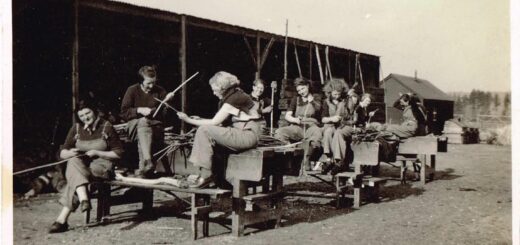January WTC Photo of the Month
For many years, I’ve created a series to mark the start of every month. These posts have covered a range of topics: from the intricacies of running the WLA, Land Girls at work, as well as at rest, to last year’s county focus on Land Girl’s activities.
I’ve tried to focus on a different part of the WLA experience and share this in an interesting and engaging way each month. Most of these previous monthly posts have focused on Land Girls. 2021 marks the year of the Lumber Jill.
At the start of every month in 2021, I’m going to share a photo of the month, spotlighting the work of the Women’s Timber Corps. For some of you who may not know, the Women’s Timber Corps was set up in 1942 to recruit women to work in forests around the country. Why was this important? The occupation of Norway as well as a lack of shipping space meant that Britain could no longer rely on imports of wood supply. We needed to turn to our own forests, and our own women, to make it happen.
Our first photograph of the month is a montage belonging to Joyce Smith (née Pearce). Joyce, known as Joy, began her life in the Women’s Timber Corps in February 1943, where she completed her training at Culford Camp in Suffolk. She then worked in Wotton-under-Edge in Gloucestershire. The following montage shares photographs of fellow Lumber Jills Joyce and Hilda, as well as June, the daughter of the family Joy stayed with.

Joy has also affixed her WLA armband, which includes two half-diamonds indicating one year’s full service. Underneath is her WTC badge and two crossed-axes badges, as well as a WLA badge.
The Women’s Timber Corps was a separate organisation to the Women’s Land Army, run by the Ministry of Supply. It was therefore important for women to have their own distinct identity as Lumber Jills. The WTC badge showcasing a fir tree and axes, as well as the iconic beret, were important visual distinctions between the WTC and the WLA.
Finally, on the far right-hand side, Joy positioned a tree trunk with the signatures of fellow Lumber Jills and others that she worked with. She has carefully transcribed their names below.
Women sought to record their wartime work in a range of ways. Maybe we can interpret Joyce’s montage as a memory board, mixing official items marking her wartime service with homemade items, such as the autographed tree trunk. These items function as important sites of remembrance for women like Joyce.
If this post has wetted your appetite, you can find out more about Joy’s time in the WTC by listening to her interviews with her son-in-law Robin Daly, and viewing photographs from her collection.
Did you or a member of family work in the Women’s Timber Corps? If so, then get in touch.
All it now leaves me to do is to wish you a happy and healthy 2021.


